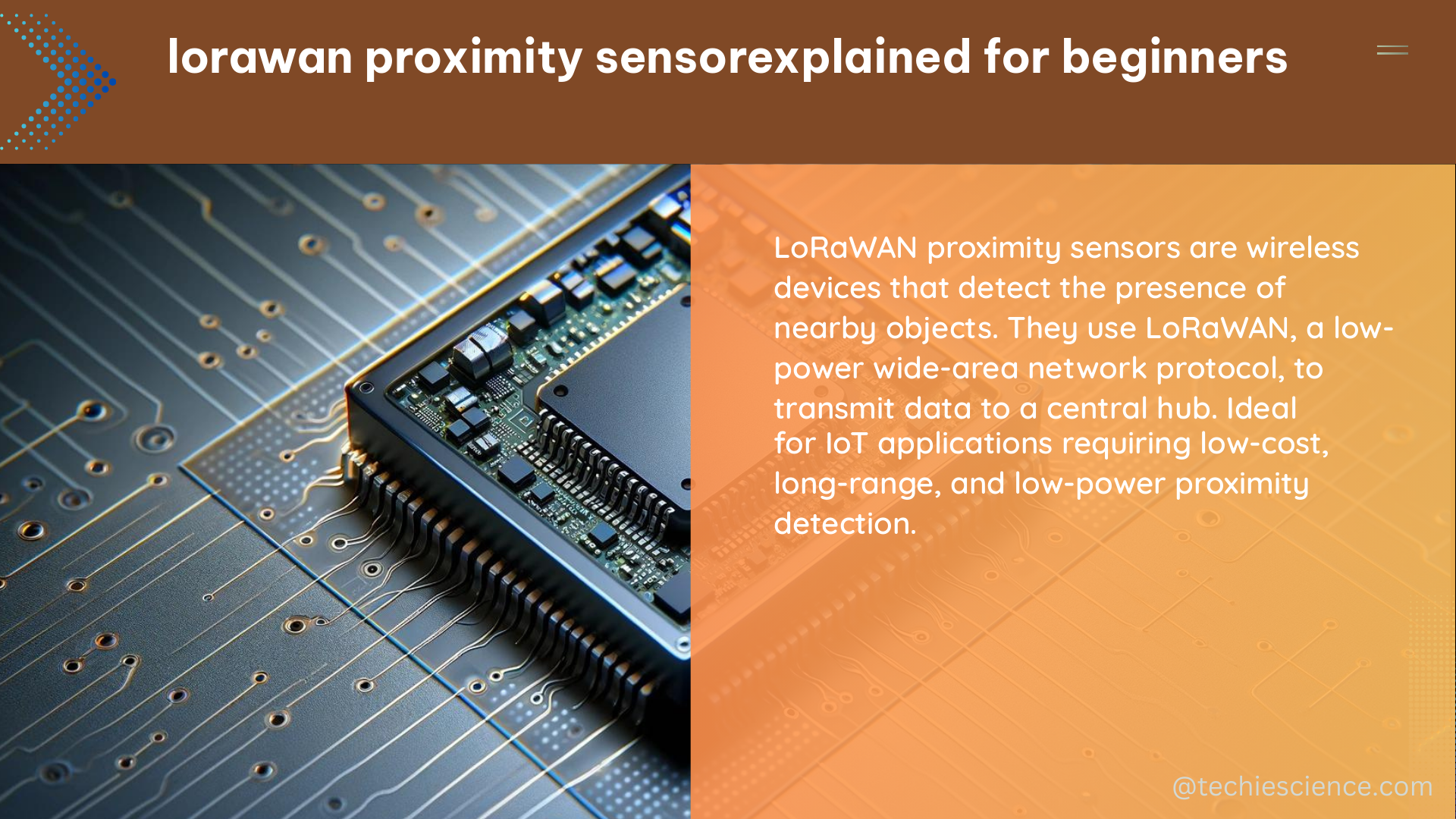LoRaWAN (Long Range Wide Area Network) is a wireless communication protocol designed for Internet of Things (IoT) applications that require long-range communication, low power consumption, and secure data transmission. Proximity sensors are devices that detect the presence or absence of an object within a certain range and can be integrated with LoRaWAN to enable remote monitoring and automation.
Technical Specification of LoRaWAN
-
LoRa Physical Layer: LoRaWAN uses the LoRa physical layer, which is a proprietary chirp spread spectrum modulation technique. This technique enables long-range communication of up to several kilometers in rural areas and up to 1 kilometer in urban areas, with low power consumption.
-
Device Types: LoRaWAN supports two types of devices: Class A (bi-directional) and Class C (continuous listening). Class A devices support bi-directional communication with a short receive window after each uplink transmission, while Class C devices support continuous listening with a dedicated receive window.
-
Network Topology: LoRaWAN uses a star-of-stars topology, where each device communicates with a gateway that forwards the data to a network server. The network server manages the communication between the devices and the application server.
-
Frequency Bands: LoRaWAN supports multiple frequency bands, including 868 MHz (Europe), 915 MHz (North America), and 433 MHz (Asia-Pacific), allowing for global deployment and roaming.
-
Encryption: LoRaWAN uses AES-128 encryption to secure the data transmission between the devices and the network server, ensuring the integrity and confidentiality of the transmitted data.
Building a LoRaWAN Proximity Sensor

To build a LoRaWAN proximity sensor, you will need the following components:
| Component | Example |
|---|---|
| LoRaWAN-enabled Microcontroller | Arduino MKR WAN 1300, Raspberry Pi Pico W with LoRaWAN shield |
| Proximity Sensor | Infrared, Ultrasonic, Capacitive |
| LoRaWAN Gateway | The Things Network, LORIOT |
| Network Server | The Things Network, LORIOT |
| Application Server | Node-RED, AWS IoT |
Here are the steps to build a LoRaWAN proximity sensor:
-
Choose a Proximity Sensor: Select a proximity sensor that suits your application requirements. For example, an infrared sensor can detect the presence of an object within a short range, while an ultrasonic sensor can detect the distance of an object within a longer range.
-
Connect the Sensor to the Microcontroller: Connect the proximity sensor to the microcontroller. For instance, if you are using an Arduino MKR WAN 1300, you can connect the sensor to the analog or digital input pins.
-
Program the Microcontroller: Program the microcontroller to read the sensor data and transmit it to the LoRaWAN gateway using the LoRaWAN protocol. You can use the Arduino IDE or other programming tools to write the code.
-
Join the LoRaWAN Network: Join the LoRaWAN network using the credentials provided by the network server. For example, if you are using The Things Network, you can register the device and obtain the necessary keys and IDs.
-
Configure the Network Server: Configure the network server to forward the data to the application server. For instance, if you are using Node-RED, you can create a flow to receive the data and process it.
-
Visualize the Data: Visualize the sensor data using the application server. For example, you can create a dashboard to display the sensor data in real-time.
Measurable and Quantifiable Data
-
Long-Range Communication: LoRaWAN can transmit data over long distances, up to several kilometers in rural areas and up to 1 kilometer in urban areas, with low power consumption (less than 100 mW).
-
Global Deployment: LoRaWAN supports multiple frequency bands, enabling global deployment and roaming capabilities.
-
Secure Data Transmission: LoRaWAN uses AES-128 encryption to secure the data transmission between the devices and the network server, ensuring the confidentiality and integrity of the transmitted data.
-
Flexible Communication: LoRaWAN supports both Class A (bi-directional) and Class C (continuous listening) devices, enabling flexible communication and power management strategies.
-
Scalable Deployments: LoRaWAN can support up to 100,000 devices per gateway, enabling scalable and cost-effective IoT deployments.
References:
– Movement detection across a proximity sensor array? – Edge Impulse: https://forum.edgeimpulse.com/t/movement-detection-across-a-proximity-sensor-array/1609
– IoT Fundamentals: Networking Technologies, Protocols, and Use Cases for the Internet of Things: https://nibmehub.com/opac-service/pdf/read/IoT%20Fundamentals.pdf
– DataBits: Experimenting with LoRaWAN for Sensor Data – LTER: https://lternet.edu/stories/databits-experimenting-with-lorawan-for-sensor-data/
– Artificial Intelligence and Sustainable Computing. Proceedings of ICSISCET 2021: https://dokumen.pub/artificial-intelligence-and-sustainable-computing-proceedings-of-icsiscet-2021-9789811916526-9789811916533.html
– How LoRaWAN® Delivers Quantifiable ROI for IoT – YouTube: https://www.youtube.com/watch?v=294YG9Z4ByE

The lambdageeks.com Core SME Team is a group of experienced subject matter experts from diverse scientific and technical fields including Physics, Chemistry, Technology,Electronics & Electrical Engineering, Automotive, Mechanical Engineering. Our team collaborates to create high-quality, well-researched articles on a wide range of science and technology topics for the lambdageeks.com website.
All Our Senior SME are having more than 7 Years of experience in the respective fields . They are either Working Industry Professionals or assocaited With different Universities. Refer Our Authors Page to get to know About our Core SMEs.